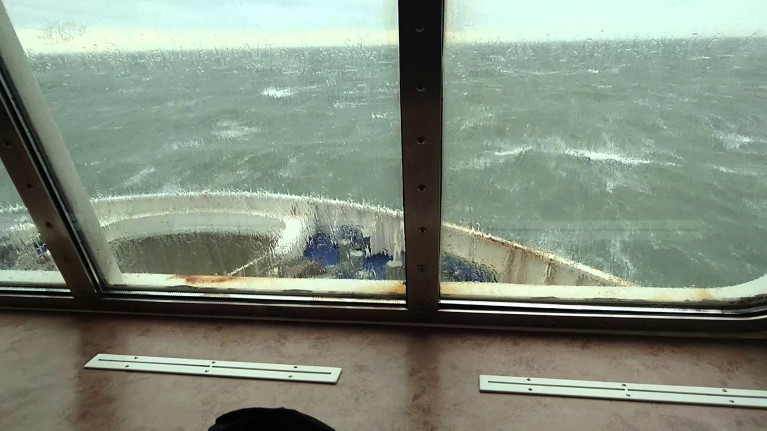Displaying items by tag: Ride out storm
Storm Barra Batters Dublin Bay with Ships Caught Up in High Seas
As Storm Barra struck Dublin Bay this morning at around 0530hrs, bringing severe and damaging wind gusts as Met Eireann forecast along with issuing a Status Orange warning, a ferry in the capital port would just a few hours later require tug assistance, writes Jehan Ashmore.
The ferry Stena Adventurer when attempting to vacate the berth on a sailing bound for Holyhead, however got into difficulties. This led to the dispatch of Dublin Port Company (DPC) tugs Shackleton and Beaufort to safely bring the ferry temporarily to a nearby quay, albeit on the opposite side facing the river Liffey's northside ferry terminal.
In a statement sought from Afloat, Stena Line cited the reason to call in the tugs was because “the Stena Adventurer (which had) departed this morning on time but on entering the river the vessel was met by very heavy gusts which prevented the ship from leaving the river.
The vessel was then held alongside on the South Bank Berth (46/47) by tugs for a time until there was an appropriate lull in the weather, in accordance with standard safety protocols,and then the ship continued on its journey to Holyhead.”
Ferry Rides Out Storm
Afloat subsequently tracked Stena Adventurer pass the Dublin Bay Buoy just after 10.00 and when bound for Holyhead, from where the outbound Stena Estrid had already departed on schedule from the north Wales port.
Stena Estrid which is the second ferry that serves Stena's Ireland-Wales route however upon arrival into Dublin Bay at around 12 noon, was unable to enter the port. Instead the ferry took a new course from off the North Burford Buoy and soon afterwards Afloat observed the ferry head towards The Muglins beacon lighthouse off Dalkey, marking the south of Dublin Bay.
During lunchtime the Stena Estrid remained off the east coast while offshore between Bray Head and Greystones Harbour before turning around in the opposite direction. The ferry is riding out the storm and is to make another attempt to enter Dublin Port, with the port expecting an arrival of 14.45hrs.
It wasn't just ferries subjected to Storm Barra, as no sooner had the DPC tug twins returned to their recently relocated station, when their services were required yet again and within an hour or so of their brief berthing.
This time it was the Seatruck Ferries ro-ro Seatruck Pace (see previous coverage) which having arrived from Heysham, sought the tugs aid when within the port's shipping fairway. The Shackleton was off the freight-only ferry's bow, while amidships off the port side was Beaufort, a name particularly apt given the stormy seas. The freighter finally berthed at around 11.20, despite the conditions the ship berthed under an hour late of its scheduled arrival.
According to Seatruck's website, however the corresponding return crossing this afternoon to the north-west English port has been cancelled and as well for a fleetmate, Seatruck Progress, whose sailing to Liverpool which was scheduled for earlier this morning.
As of this afternoon Stena Adventurer completed its sailing with an arrival in Holyhead with Irish Ferries Ulysses astern but at time of writing the ferry also from Dublin remains outside the Anglesey port.





























































